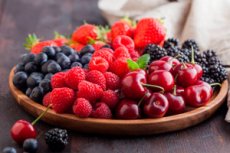New publications
Study: genes influence anti-cancer efficacy of fruit and fiber
Last reviewed: 02.07.2025

All iLive content is medically reviewed or fact checked to ensure as much factual accuracy as possible.
We have strict sourcing guidelines and only link to reputable media sites, academic research institutions and, whenever possible, medically peer reviewed studies. Note that the numbers in parentheses ([1], [2], etc.) are clickable links to these studies.
If you feel that any of our content is inaccurate, out-of-date, or otherwise questionable, please select it and press Ctrl + Enter.

A recent study published in the journal eBioMedicine has identified genetic variations that may modify the association between fiber, fruit, and vegetable intake and colorectal cancer (CRC) risk. The researchers successfully identified two significant loci that modify the association between fiber and fruit intake and CRC risk.
CRC is one of the most common cancers in the world, with nearly two million new cases and over 900,000 deaths in 2020. High intake of fruits, vegetables, whole grains, and dietary fiber has been reported to reduce the risk of CRC. Although there is strong evidence of an association between CRC risk and whole grain and dietary fiber intake, evidence of an association between CRC risk and fruit and vegetable intake remains limited.
Previous genome-wide association studies (GWAS) have identified at least 200 loci associated with CRC risk, explaining up to 35% of heritability. Although gene-environment (G × E) interactions can explain additional heritability, previous studies with small samples and traditional methods have found only a limited number of significant interactions. New statistical approaches, such as conjoint tests and two-step methods that prioritize single nucleotide polymorphisms (SNPs), have the potential to improve the accuracy of these analyses.
Up to 45 studies from three CRC genetic consortia including individuals of European descent were included in the analysis. Studies included case-control sets for cohort studies and cancer-free controls for case-control studies. A total of 69,599, 69,734, and 44,890 participants were analyzed for fruit, vegetable, and fiber intake, respectively. Dietary intake was assessed using food frequency questionnaires and dietary histories, typically expressed as servings per day for fruits and vegetables and grams per day for total fiber.
Data were harmonized and expressed as quartile values by sex and study. In addition, genotyping quality control included checking for missing data, Hardy-Weinberg equilibrium, and sex mismatch, followed by imputation and filtering for minor allele frequency and accuracy, resulting in an analysis of 7,250,911 SNPs.
Compared with controls, participants with CRC were older, had higher body mass index and energy intake, and a higher prevalence of risk factors such as family history of CRC and type 2 diabetes. They also consumed less fiber, fruits, and vegetables compared with controls. Meta-analyses found an inverse association between fiber (relative risk per quartile increase (OR) = 0.79), fruits (OR = 0.79), and vegetables (OR = 0.82) intake and CRC risk.
The 3-DF test identified the rs4730274 locus upstream of the SLC26A3 gene, which shows an association with fiber intake and an interaction with CRC risk. Stratification by genotype showed a stronger inverse association between fiber and CRC for each copy of the T allele. Functional annotation suggested enhancer activity in colon tissues, with an eQTL for the DLD gene.
The rs1620977 locus near the NEGR1 gene showed a significant association with fruit consumption and a moderate interaction with CRC risk. Strong inverse associations were observed with increasing fruit consumption for each copy of the G allele.
The study is the largest G×E study to date, in which the researchers identified two interactions between fiber, fruit intake, and CRC risk. Specifically, rs4730274 near the SLC26A3 gene suggests a significant association between fiber intake, gut function, inflammation, and CRC. The results call for further studies to examine the clinical implications and confirm these findings in different populations.
